Colt 1849 Pocket
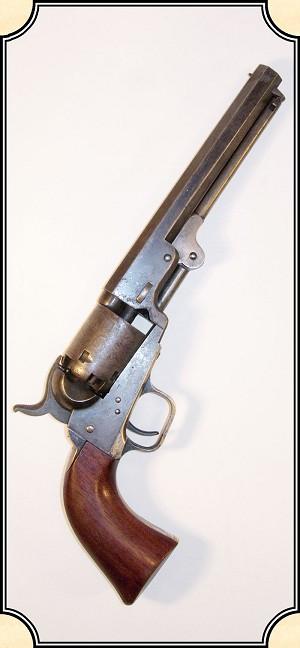
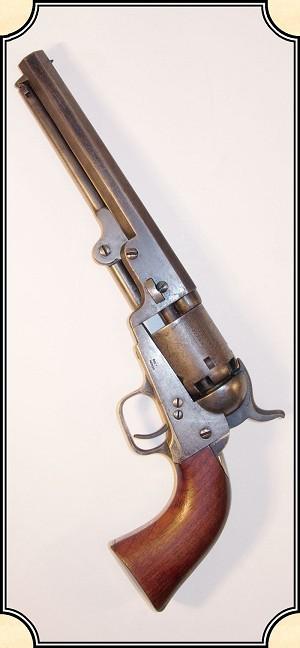
Colt model 1849 pocket pistol
by Mike Cumpston
By the late 1840s, Samuel Colt’s revolvers had demonstrated their utility on the Texas Frontier and in the war with Mexico. Colt's experiences with military contracts had convinced him that his business would have to serve a much larger and more stable market in order to survive and grow. In 1847, he announced plans to produce a revolver of manageable size and simple construction that would be useful to the general public.
The design that emerged was the .31 caliber Baby Dragoon. This small-framed revolver used fewer action parts than the earlier martial revolvers. The size made it suitable for comfortable and discrete carry. The time was ripe, as the Mexican War had opened a vast area of Western territory for expansion. The volatile political climate of the times prompted citizens across the continent to look to themselves for personal protection.
With the addition of an attached loading lever and other refinements, the Baby Dragoon became the Pocket Model of 1849. It arrived on the scene just in time to satisfy the demand created by the California Gold Rush and remained in production until 1872. (Shumaker reports production of 3,000 units between 1872 and 1875.)
Peak years occurred in the early 1850's Gold Rush period and during the Civil War years. The Colt single-action lock-work came to maturity in the model of 1849 and formed the basis for the Navy and Army models to come. While these larger pistols achieved more historical recognition, the Pocket Model remained Colt's best selling revolver throughout the percussion era. Total production reached 340,000 units.
When the Pocket Model arrived on the scene, the closest tactically equivalent small handgun was the Allen pepperbox. Most pocket-sized pistols were of the single shot Derringer-type with a few designs capable of repeat fire by use of multiple barrels. The only apparent advantage possessed by those contemporary pistols was the availability of more effective calibers and loads.
The Model of 1849 was a much trimmer package than the majority of the Allen revolvers and had a definite accuracy advantage as range increased. Then, as now, many handgun carriers were perfectly happy with mousegun ballistics. The Pocket Model maintained a strong market presence even after the introduction of the slightly larger .36 caliber Pocket Police and Pocket Navy Models.
In recent years it has become a popular, if inaccurate conceit, among the anti-gun crowd that Samuel Colt invented the American Gun Culture as a marketing tool. Historical revisionism aside, Colt's introduction and promotion of the 1849 Pocket Model certainly did democratize personal armament in a manner most consistent with the American experience.
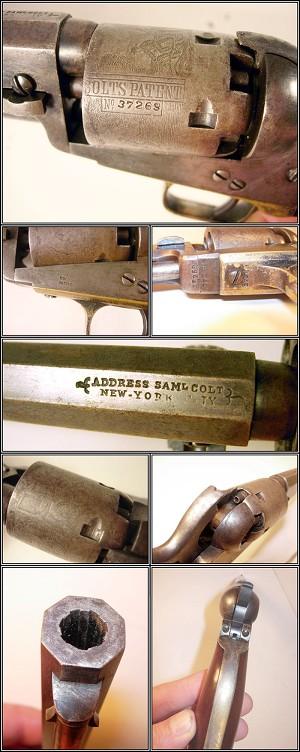
Sub Models
The Colt Model 1848 Baby Dragoon Revolver was manufactured in Hartford from circa l847 through to 1850 with a total of about 15,000 produced. Serial numbers are found on all major parts and range from 1 through to about 15500 overlapping with the Colt Model 1849 Pocket.
The five-shot Baby Dragoon in .31 caliber was a scaled down version of the large dragoon revolvers but lacking a loading lever. It was the first pocket model to be made at Colt's Hartford factory. It came in barrel lengths of 3", 4", 5", and 6" and is distinctive with its square-back trigger-guard. From about serial number 11670 a loading lever was attached to some revolvers through to serial number 15461. Baby Dragoon revolvers with attached loading levers are rare. Beware of fakes.
The two-line barrel left or right-handed address on early revolvers reads 'ADDRESS, SAML COLT/NEW.YORK CITY'. Later addresses are ADDRESS SAML COLT/NEW-YORK CITY' with a dash at either end. There were several variations noted, some corresponding with the changes of the address dies. On the left side of the frame is stamped COLTS/PATENT. The five-shot cylinder scene on early revolvers is a part of the Texas Ranger and Indian fight roll as was standard on the 44 caliber Dragoons. At around the serial range of 11100 the familiar stagecoach holdup design was introduced.
The Baby Dragoon had a blued barrel and cylinder with casehardened frame, hammer and lever. The brass back-strap and square-back trigger-guard were silver-plated. The one-piece grips were made of varnished walnut. There are many variations of the Baby Dragoon within its serial range. Revolvers without a loading lever do not have loading cutouts on the right side of the barrel lug. The stops which index to align perfectly the cylinder to the barrel, range from being round, slightly oval, oval and rectangular on later pistols. Most cylinders have only one safety pin on the rear. From the serial range of about 11600 five safety pins between each chamber were introduced. There were also changes on the hammer face, cylinder ratchet, cut-out on the right side of the barrel, 'Colt's Patent' stamping, trigger-guard bolsters, length of frame and recoil shield with or without capping groove. It is estimated that less than one thousand were engraved and less than one hundred were cased.
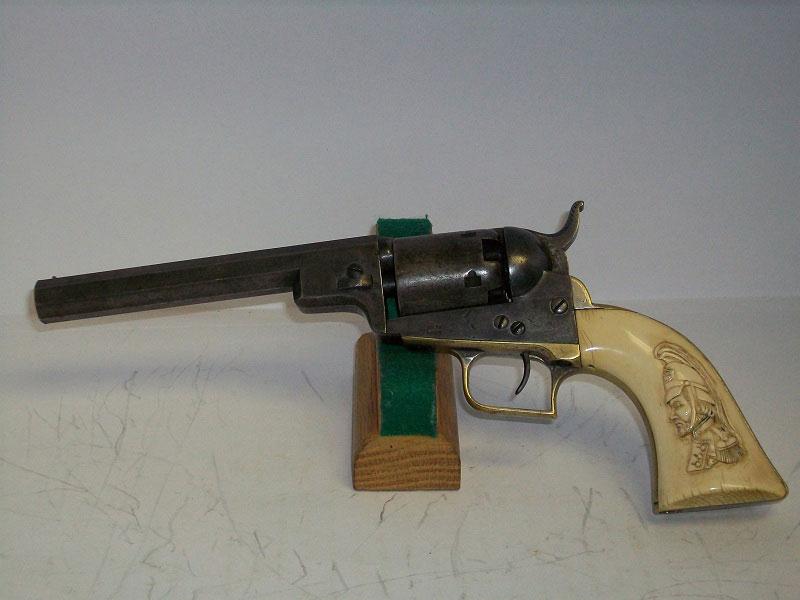
The Colt Model 1849 London Pocket revolver was manufactured at the London factory from circa 1853 through to 1857 with its own serial range from 1 through to approximately 11000. The quality of the London Pocket was thought to be better than its American counterpart. The five-shot .31 caliber London Pocket has an octagonal barrel with loading lever and came in three different barrel lengths of 4”, 5” and 6”. The frame was stamped on the left side of all revolvers with COLTS/PATENT’ and the cylinder had the roll design of the stagecoach holdup scene. On engraved guns the ‘COLT’S/PATENT’ would be hand-engraved. Revolvers were finished with a blue barrel and cylinder with casehardened frame, hammer and loading lever. The steel back-strap and trigger-guard found on most London Pocket revolvers after serial number 1000 were either blued or silver-plated. The grips almost always are one-piece varnished walnut and one-piece select burl walnut grips on engraved specimens or special order revolvers.
On early London Pockets the parts were manufactured at the Hartford factory and shipped to the London factory where they were assembled and finished. The imported back-straps and small trigger-guards were made of brass and are found on revolvers up to about serial number 1000. Several early addresses are found including hand engraved ‘SAML COLT LONDON’ on #26, ‘COLN COLT. LONDON.’ on #52 and ‘ADDRESS SAML COLT/LONDON’ with long finials at either end on #65. All are left-handed reading from breech to muzzle. The most common address found on London Pockets is the two-line ‘ADDRESS COL COLT./LONDON’ with a bracket and finials at both ends reading muzzle to breech. There are several variations of this address.
All London manufactured revolvers were required by the British Government to be proof fired and stamped on alternate chambers of the cylinder with Crown over GP and Crown over V. Also the barrel was proof marked with both stamps stacked on top of each other on the left side of the barrel lug. Late London Pockets were sold into the American market being made up from parts that were shipped back to Hartford after the London factory closed in 1857. Many of these will not be British proofed. It is estimated that about eleven hundred were engraved in London by factory engravers and more than three thousand of the production were cased.
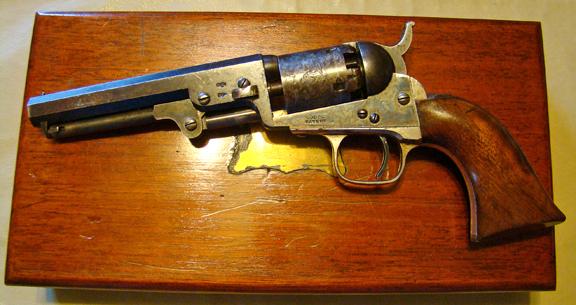
The re-classified Colt Pocket Model 1865 of Navy Caliber percussion revolver or Pocket Navy was previously known to collectors as the "Model of 1853" or the "Model 1862 Pocket Navy". It is now more correctly termed the "Colt Pocket Model of 1865 of Navy Caliber" or "Colt Pocket Model of Navy Caliber" or merely "Pocket Navy."
It is now deemed to have been manufactured from 1865 through to circa 1872 in its own serial range from serial number one. It is estimated that approximately 22,500 were manufactured. The Pocket Navy, like the 1862 Police was chambered in .36 caliber with a five shot rebated round cylinder. It had an octagonal barrel with hinged loading lever which was a similar style to the 1851 Navy revolver. The Pocket Navy was manufactured in the three barrel lengths of 4½, 5½ and 6 ½ inches.
The frame, hammer, and lever were case-hardened and the remainder of the revolver was blued. The grips were of one-piece walnut with silver-plated brass back-strap and trigger-guard. The barrel address was ‘ADDRESS COL. SAM COLT NEW-YORK U.S. AMERICA’ with ‘COLTS/PATENT’ stamped on the left side of the frame. The cylinder roll engraving portrayed the stagecoach holdup scene. Many of the late production Model 1865 Pocket Navy revolvers were converted from percussion to cartridge use. Please see the small frame conversion section.
Some Colt Model 1865 Pocket Navies were shipped to the Pall Mall Agency in London. They are usually found with iron grip-straps with an L (denoting London) beneath the serial numbers and British proof-marks on the barrel and cylinder. Very few are found with the rare barrel address: ADDRESS COL. COLT/LONDON. This is considered a very rare variation.


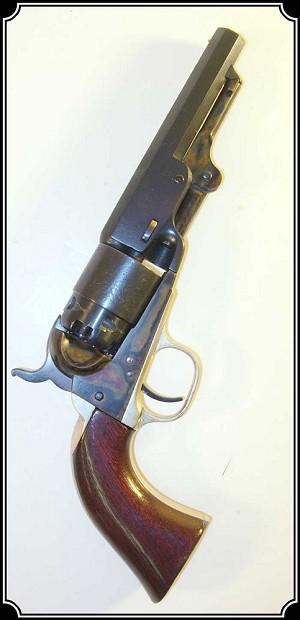
Maak jouw eigen website met JouwWeb